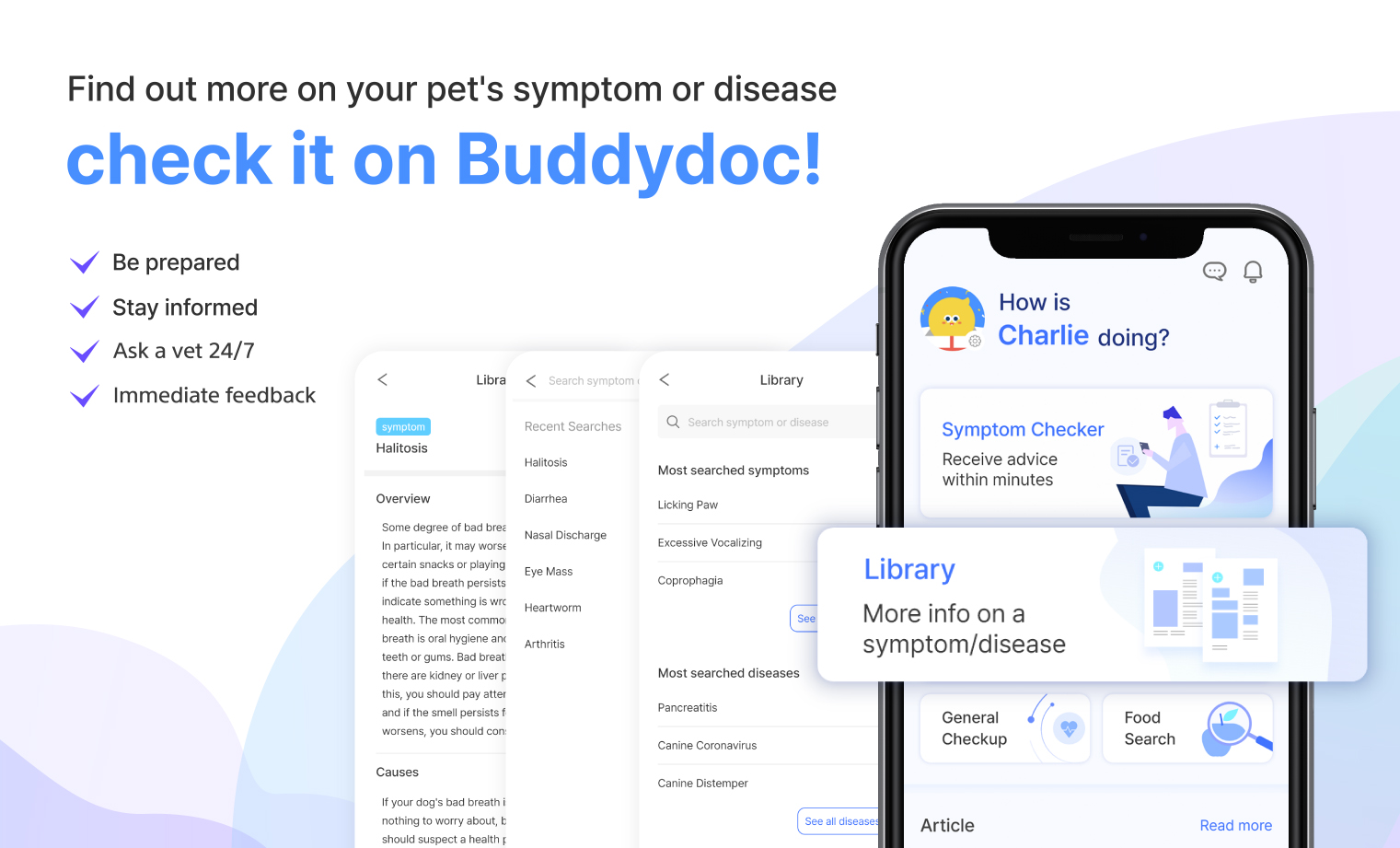DISEASES
Pancreatitis in Dogs - Symptoms and Treatments
페이지 정보
본문


Overview
Pancreatitis refers to the condition in which the pancreas becomes inflamed and damages this vital organ's functionality. This condition is potentially life-threatening in dogs, and knowing the signs to look out for can help save a lot of stress and trouble for you and your dog. Pancreatitis can occur acutely or chronically at any age and affect any breed and sex. The pancreas helps to produce enzymes to help digest food and produce hormones to regulate the dog’s blood sugar levels. When this function weakens, common clinical symptoms include nausea, vomiting, and decreased appetite.
In acute pancreatitis, digestive enzymes enter the abdominal cavity and cause secondary damage to the liver, bile duct, gallbladder, and intestines. Chronic pancreatitis develops slowly over a long period, and no specific clinical symptoms may appear as the condition develops. Pancreatitis is a potentially life-threatening condition, so if these symptoms occur, you should visit a hospital immediately and receive appropriate treatment.
The Leading Causes of Pancreatitis in Dogs
There is no single cause of pancreatitis found in dogs. However, it can be related to several factors, such as diet, obesity, endocrine disorders, etc.
The following is a list of common causes of pancreatitis in dogs.
-
Diet
A high-calorie or high-fat diet is one of the most common causes of pancreatitis. Human food, in particular, increases the risk of developing pancreatitis.
-
Obesity
Obese dogs are more likely to develop hyperlipidemia, which can lead to pancreatitis.
-
Endocrine disorders
Endocrine disorders such as hypothyroidism, hyperadrenocorticism/Cushing's disease, and diabetes mellitus can lead to pancreatitis.
-
Exposure to drugs and toxins
Certain drugs and poisons, such as animal venom, zinc poisoning, certain medications, etc., can cause pancreatitis in dogs.
-
Breed predisposition
There are correlations between certain breeds that are prone to developing pancreatitis compared to others, such as Miniature Schnauzers and Yorkshire terriers.
-
Severe Trauma
Blunt trauma can cause a chain reaction that lead to pancreatitis depending on how severe the trauma is.
What Are the Signs and Symptoms of Pancreatitis in Dogs?
The main symptoms of pancreatitis are repeated vomiting and excruciating abdominal pain. You should see a veterinarian if your puppy seems lethargic, continuously vomits, or has stomach pains.

Monitor closely for the following symptoms:
-
Repeated vomiting
-
Abdominal pain or bloating:
Pancreatitis causes severe abdominal pain. Your dog will show signs of pain when you touch its belly, or it may assume a hunched back position or a praying position in which the hind legs are raised, and the front legs are lowered.
-
Diarrhea
-
Loss of appetite
-
Decreased energy
-
Dehydration
Dehydration is caused by the frequent vomiting and diarrhea symptoms of pancreatitis. Signs of dehydration may appear either as dry gums or loss of elasticity in their skin.
-
Fever
When to See a Vet if you Suspect Pancreatitis in Your Dog
Unfortunately, the answer is immediate. Early-aggressive treatment is recommended and should be taken seriously. Pancreatitis is a very severe condition and, if left untreated long enough, can cause systemic complications. Pancreatitis causes abdominal pain and, if severe, causes a systemic inflammatory response and affects various organs, especially the digestive organs. Dehydration due to repeated vomiting and diarrhea caused by pancreatitis can cause electrolyte imbalance and affect blood flow, leading to kidney problems. Pancreatitis that has been going on for a long time can cause other problems. Exocrine pancreatic insufficiency can occur if the digestive enzyme-producing cells are damaged. Also, if too many hormone-producing cells are destroyed, insulin production diminishes, which can lead to diabetes. If several significant clinical symptoms of pancreatitis appear simultaneously, you must visit a veterinary hospital immediately. If you have bloody diarrhea or become dehydrated, this emergency requires immediate action.
Is There Home Treatment if I Suspect Pancreatitis in my Dog?
Pancreatitis is a severe condition that a veterinarian must treat. If a problem suddenly arises at night or dawn, or if you cannot visit the hospital immediately, the following measures can help before visiting the veterinarian. If you are feeding a high-fat diet, you should replace it with a low-fat diet. Digestive symptoms due to pancreatitis can lead to insufficient nutritional support and dehydration. Water loss from repeated vomiting and diarrhea can cause serious problems, so ensure your dog drinks plenty of water. If your dog loses its appetite, try to feed smaller amounts more frequently instead.
How is Pancreatitis Diagnosed?
During your initial visit, your veterinarian will ask several questions to accurately determine your pet's condition. Your veterinarian will decide which additional tests to perform to confirm pancreatitis based on your answers.
Your vet may ask these questions to diagnose pancreatitis in your dog.
- When did your pet start vomiting or having diarrhea?
- How many times a day does your pet vomit and has diarrhea?
- What kind of dog food and snacks do you feed your dog?
- Do you often feed human foods to your dog?
- Is your pet currently taking any medications or supplements?
- Is your dog drinking more water than usual or urinating more frequently?
For an accurate diagnosis, pancreatitis is then diagnosed through the following tests:
-
Basic physical examination
Measure body temperature, heart rate, respiratory rate, etc., and check for dehydration. Dehydration is checked by looking at loose skin, dry gums or nose, or sunken eyes.
-
Blood test (cPLI)
Blood is taken and tested for a pancreatic enzyme called cPLI. This enzyme helps indicate how active the pancreas is, as dogs with pancreatitis, the number increases.
-
Abdominal radiograph (X-ray)
Vomiting/diarrhea is a non-specific symptom that can also appear in other digestive diseases. Therefore, to rule out other causes, an abdominal radiograph is taken to see the entire digestive system.
-
Abdominal ultrasound
Abdominal ultrasound allows more accurate observation of the organs of the abdomen. In addition, the shape of the pancreas can be seen through abdominal ultrasound to check for inflammation, and a veterinarian can observe other digestive organs more precisely. However, dogs with chronic pancreatitis may avoid detection under this method.
How is Pancreatitis Treated in Dogs?
No single treatment can treat pancreatitis, and hospitals provide supportive treatment by relieving the symptoms caused by pancreatitis.
The following are supportive treatments a vet may prescribe for a dog with pancreatitis.
-
Fluid Treatment
Dogs with pancreatitis will continue to vomit/have diarrhea and become dehydrated. As a result, electrolyte imbalance occurs, and if it becomes severe, it can lead to death, so fluid therapy is used.
-
Painkillers
Pancreatitis causes severe abdominal pain, and painkillers are prescribed to alleviate this.
-
Antiemetic
Antiemetic medication can be prescribed for dogs with severe vomiting.
-
Anti-inflammatory
A veterinarian may prescribe anti-inflammatory medications to reduce the severe inflammatory response caused by pancreatitis.
-
Nutritional Supplement
Dogs with pancreatitis will have a reduced appetite. A veterinarian can prescribe a diet with low-fat content, or if not eating well entirely, nutrients are supplemented through fluid therapy.
How Can I Help Prevent Pancreatitis for my Dog?
The unfortunate news is once pancreatitis appears in a dog, it has a high chance of recurrence. To prevent pancreatitis, you must first watch your dog's diet. Ensure that the food and snacks you feed are not high in fat, and avoid giving human foods. In the case of pancreatitis due to obesity, it is recommended to manage weight through sufficient exercise. Supplements such as omega-3 can help lower blood fat, so giving them as directed by your veterinarian may help. If left untreated, pancreatitis can become more challenging to treat and lower the quality of the dog’s life, so it is recommended to practice early-aggressive treatment at a veterinary hospital if you see the clinical signs of pancreatitis.
Find out more about your dog’s condition or symptoms in the Buddydoc Library!

The Buddydoc library is filled with everything you’d want to know about each symptom and disease your pet may experience. If you would like to find out more about the causes, signs, treatments, preventions, and more for your dog’s condition. Try out the Buddydoc app and search your pet’s symptom or condition in the Buddydoc library.












